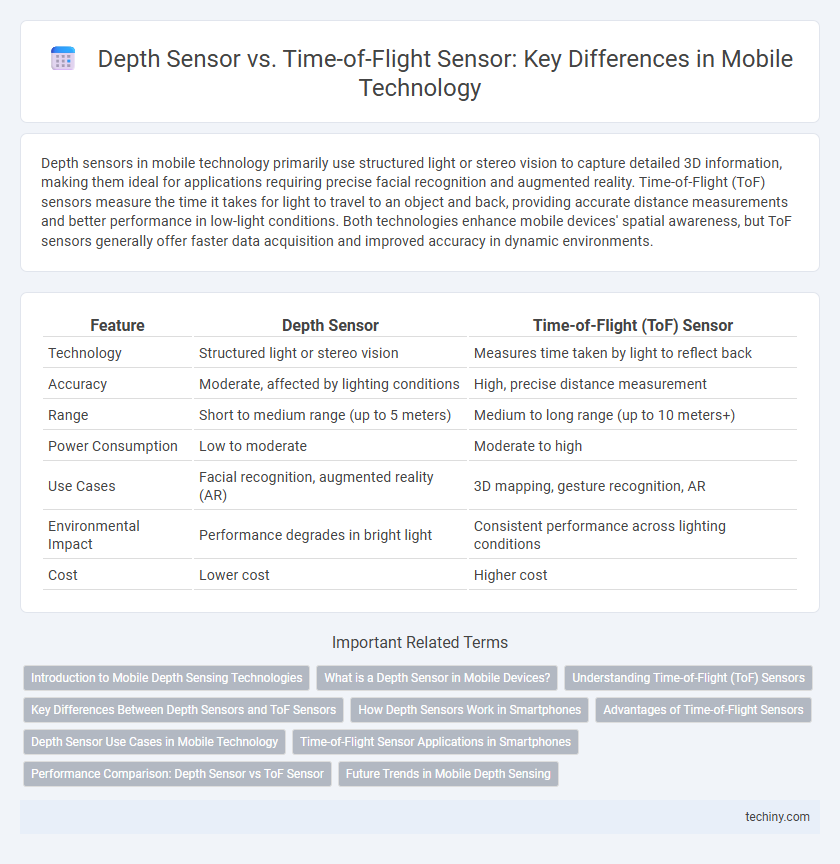Depth sensors in mobile technology primarily use structured light or stereo vision to capture detailed 3D information, making them ideal for applications requiring precise facial recognition and augmented reality. Time-of-Flight (ToF) sensors measure the time it takes for light to travel to an object and back, providing accurate distance measurements and better performance in low-light conditions. Both technologies enhance mobile devices' spatial awareness, but ToF sensors generally offer faster data acquisition and improved accuracy in dynamic environments.
Table of Comparison
| Feature | Depth Sensor | Time-of-Flight (ToF) Sensor |
|---|---|---|
| Technology | Structured light or stereo vision | Measures time taken by light to reflect back |
| Accuracy | Moderate, affected by lighting conditions | High, precise distance measurement |
| Range | Short to medium range (up to 5 meters) | Medium to long range (up to 10 meters+) |
| Power Consumption | Low to moderate | Moderate to high |
| Use Cases | Facial recognition, augmented reality (AR) | 3D mapping, gesture recognition, AR |
| Environmental Impact | Performance degrades in bright light | Consistent performance across lighting conditions |
| Cost | Lower cost | Higher cost |
Introduction to Mobile Depth Sensing Technologies
Mobile depth sensing technologies enhance augmented reality and photography by accurately measuring distances within a scene. Depth sensors use structured light or stereo vision to capture spatial information, while Time-of-Flight (ToF) sensors emit infrared light pulses and calculate distance based on the time taken for the light to reflect back. ToF sensors provide faster response times and improved depth accuracy, especially in low-light conditions, making them integral to advanced mobile devices.
What is a Depth Sensor in Mobile Devices?
A depth sensor in mobile devices measures the distance between the camera and objects in its environment by capturing spatial information, enabling accurate 3D mapping and augmented reality applications. It typically uses infrared light or structured light to generate detailed depth maps, improving portrait mode photos and facial recognition. This technology enhances real-time interaction and object detection by providing precise depth data crucial for immersive mobile experiences.
Understanding Time-of-Flight (ToF) Sensors
Time-of-Flight (ToF) sensors measure the time it takes for an emitted light signal to reflect off an object and return to the sensor, enabling precise distance mapping and depth perception in mobile devices. These sensors provide higher accuracy and faster performance compared to traditional depth sensors by capturing real-time 3D data with minimal latency. ToF technology enhances augmented reality applications, facial recognition, and low-light photography by delivering detailed spatial information crucial for advanced mobile functionalities.
Key Differences Between Depth Sensors and ToF Sensors
Depth sensors capture spatial information by measuring the distance between the sensor and objects using various technologies such as stereo vision or structured light. Time-of-Flight (ToF) sensors specifically measure the time it takes for emitted light to reflect off surfaces and return, providing precise depth data even in low-light conditions. ToF sensors typically offer higher accuracy and faster response times compared to traditional depth sensing methods but may consume more power and require more complex processing.
How Depth Sensors Work in Smartphones
Depth sensors in smartphones use structured light or stereoscopic cameras to capture spatial information by measuring the distance between the sensor and objects in the environment. These sensors emit infrared light patterns or capture multiple images from slightly different angles to calculate depth through triangulation or disparity mapping. Time-of-Flight (ToF) sensors differ by emitting a light pulse and measuring the time it takes for the light to return, enabling more precise and faster depth measurement in complex scenes.
Advantages of Time-of-Flight Sensors
Time-of-Flight (ToF) sensors provide precise depth measurements by calculating the time it takes for light to reflect off objects, enabling accurate 3D mapping and object detection in mobile devices. Compared to traditional depth sensors, ToF sensors offer faster response times and higher resolution depth data, improving augmented reality (AR) experiences and facial recognition capabilities. The compact design and low power consumption of ToF sensors make them ideal for integration into smartphones, enhancing camera performance and overall user interaction.
Depth Sensor Use Cases in Mobile Technology
Depth sensors in mobile technology enable advanced features such as augmented reality (AR) applications, facial recognition for biometric security, and enhanced photography through improved portrait mode effects. These sensors capture spatial information by calculating distance to objects, allowing devices to render realistic 3D images and interactive virtual environments. The integration of depth sensing significantly enhances user experience in gaming, navigation, and social media filters by providing accurate environmental mapping and object detection.
Time-of-Flight Sensor Applications in Smartphones
Time-of-Flight (ToF) sensors in smartphones enable precise depth mapping by measuring the travel time of light pulses, enhancing augmented reality (AR) experiences and improving camera autofocus speed. These sensors support advanced facial recognition systems by creating accurate 3D models, strengthening device security. ToF technology also optimizes low-light photography and enables real-time gesture recognition, expanding interactive capabilities on mobile devices.
Performance Comparison: Depth Sensor vs ToF Sensor
Depth sensors typically use structured light or stereo vision to capture spatial information, offering high accuracy in short-range environments but less effective in low light or long-distance scenarios. Time-of-Flight (ToF) sensors measure the time it takes for an emitted light pulse to return, providing faster response times and better performance in various lighting conditions, especially for medium to long-range detection. ToF sensors generally outperform depth sensors in speed and adaptability, making them ideal for applications requiring real-time depth mapping and dynamic object tracking in mobile technology.
Future Trends in Mobile Depth Sensing
Time-of-Flight (ToF) sensors are rapidly evolving with advancements in miniaturization and power efficiency, enabling more precise real-time 3D mapping and augmented reality applications on mobile devices. Depth sensors using structured light and LiDAR technologies are converging with ToF to enhance spatial awareness, improving mobile photography, gesture recognition, and environmental interaction. Future trends indicate integration of AI-driven algorithms will optimize depth data processing, expanding capabilities in autonomous navigation and immersive user experiences.
Depth Sensor vs Time-of-Flight Sensor Infographic

 techiny.com
techiny.com